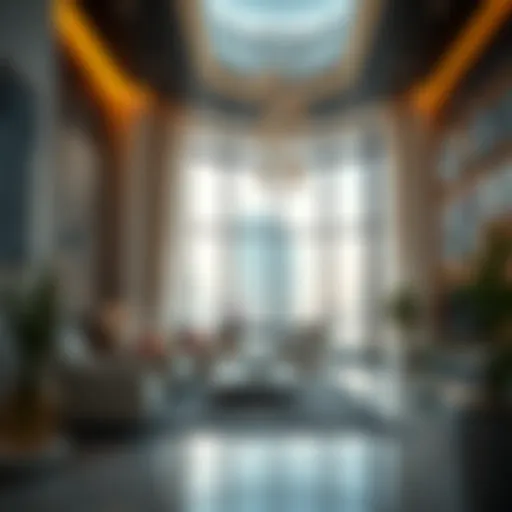The Tallest Towers in Dubai: Architectural Wonders
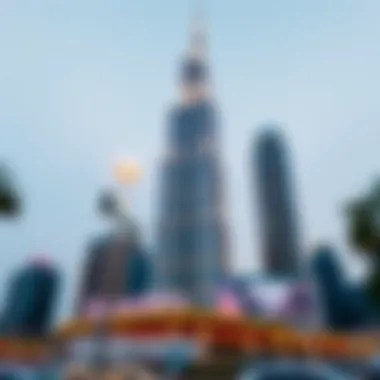
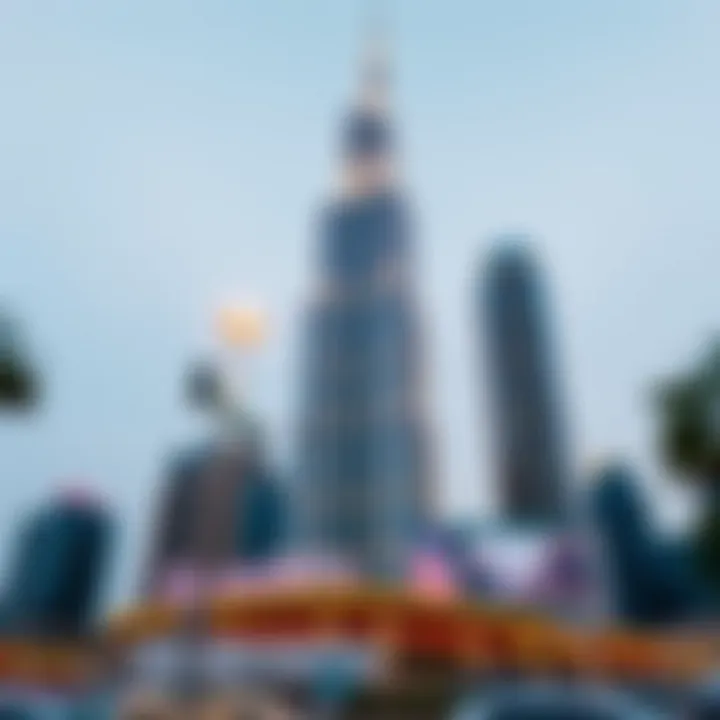
Intro
Dubai, a city where dreams reach sky-high, has made a name for itself as a hub of architectural innovation. The skyline is a tapestry of glass and steel, punctuated by towering structures that have catapulted the emirate into the global spotlight of modern architecture. Each tower tells a story, not just of design or engineering, but of the authors who carved these massive accomplishments from dreams into reality.
From the dizzying heights of the Burj Khalifa to the more contemporary marvels like the Dubai Frame, these towers are more than mere buildings; they are the beating heart of a metropolis that is ever-evolving. This article takes a closer look at the tallest towers, examining their unique designs, architectural significance, and the profound impact they wield on Dubai’s skyline and economy.
As investors, homebuyers, and property managers scour this vibrant city for opportunities, understanding the complex interplay of architecture and market dynamics is crucial. What lies beneath the surface of these impressive facades? How do they shape the cultural ethos and economic landscape? Let’s dive into the intricate relationship between these colossal structures and the phenomena of Dubai’s real estate market.
Overview of Dubai's Architectural Landscape
Dubai's architectural landscape serves as a canvas that illustrates its rapid growth and transformation from a modest desert town to a global metropolis. This evolution is not merely a reflection of ambition, but also a testament to innovation, sustainability, and cultural exchange. The towering skyscrapers that punctuate Dubai’s skyline are symbols of engineering feats, each telling a story of design, aspiration, and the essence of urban life in the 21st century.
Historical Context of Skyscraper Development
To appreciate Dubai’s current skyline, one must examine the historical backdrop of its skyscraper development. The city began to witness significant architectural advancements in the late 20th century, particularly after the discovery of oil in the 1960s. Building regulations and economic policies stimulated rapid urbanization, transforming Dubai into a hub for international business and tourism. The introduction of modern architectural styles, influenced by global movements as well as local traditions, set the stage for the iconic structures we see today.
Notably, the Burj Al Arab, which opened in 1999, marked a pivotal point in the city's architectural narrative. Constructed to resemble a sail, this hotel not only redefined luxury but also showcased ambitious engineering methodologies that allowed for unique and bold designs. It was a precursor to the more audacious towers that would follow in its footsteps, essentially laying the groundwork for what Dubai would become — a frontier for architectural experimentation.
The Role of Design in Modern Architecture
Modern architecture in Dubai is characterized by a blend of functionality and aesthetic appeal. The designs are not just about height; they are about creating spaces that enhance the lifestyle of inhabitants while reflecting cultural nuances. Architects such as Adrian Smith, who designed the Burj Khalifa, emphasize not only height but also integration with the environment and community consciousness.
Key elements in modern designs include:
- Innovative Materials: Use of glass and steel for aesthetic and structural benefits.
- Sustainable Practices: Many buildings are designed with energy efficiency in mind, employing solar panels and advanced water recycling systems.
- Cultural Reflection: Elements derived from Emirati heritage are often interwoven into designs, creating a distinctive identity that honors the past while embracing the future.
Thus, the architectural scene in Dubai serves both functional purposes and an artistic narrative, creating spaces that resonate with residents and visitors alike.
Influence of Global Trends on Dubai's Skyline
Dubai’s skyline is a vibrant tapestry woven from global influences. As international architects flock to the city, they bring with them a myriad of design philosophies. The results are stunning and diverse structures that defy conventions and challenge engineering limits.
- Postmodern Architectural Styles: Many of the skyscrapers incorporate postmodern elements, characterized by eclectic designs and playful forms, drawing inspiration from global cities like New York and Tokyo.
- Sustainable Architecture Movements: With a growing awareness of environmental issues, there is a considerable shift toward sustainability in architectural practices. This trend empowers buildings to coexist harmoniously with their surroundings and promote energy efficiency.
- Technological Integration: As the world becomes more interconnected through technology, Dubai has embraced advanced building techniques such as parametric design, which allows for more organic forms that defy traditional architectural geometry.
"The skyline of Dubai does not reflect just a city’s growth; it is a mirror of global aspirations, where East meets West in a linguistic dialect of soaring heights and avant-garde vision."
While reflecting local values, the towering structures symbolize globalization, highlighting how Dubai has positioned itself as a nexus of trade, culture, and innovation on the world stage.
Burj Khalifa: An Icon of Modern Engineering
The Burj Khalifa stands as a towering monument to modern engineering, capturing the imagination of millions while epitomizing Dubai’s relentless pursuit of innovation. Structurally, it not only redefines what is achievable in skyscraper design but serves as a beacon, drawing tourists and investors alike to the heart of the city. As the tallest building in the world since its completion in 2010, its significance expands beyond mere height; it influences economic, cultural, and social landscapes in ways that resonate deeply throughout Dubai and beyond.
Design and Construction
The design of the Burj Khalifa is as intriguing as it is impressive. Created by the renowned architecture firm Skidmore, Owings & Merrill, the tower's architecture takes inspiration from Islamic architecture — specifically the slender minarets found amidst many mosques. The structure rises to a staggering height of 828 meters, composed of 163 floors above ground, showcasing a mix of glass, steel, and reinforced concrete. This design harnesses both aesthetic appeal and structural functionality.
The construction process was a symphony of coordination and technological excellence. Over 12,000 workers contributed to building the Burj Khalifa, with construction materials sourced from over 100 different countries. One notable challenge was the unique high-altitude wind patterns, which influenced the structural design, ensuring stability and safety. This state-of-the-art construction approach offers valuable lessons about innovation and project management for investors and developers in high-rise constructions.
Cultural Impact and Global Recognition
The Burj Khalifa is more than just a building; it's a cultural phenomenon. It symbolizes Dubai's ambitious vision and is an emblem of what can be achieved with the right blend of vision, investment, and technology. Since its inauguration, it has garnered worldwide recognition, appearing in numerous films, music videos, and advertisements, thus solidifying its status as an iconic masterpiece.
"The Burj Khalifa has altered perceptions of Dubai — not only as a destination but as a global icon of prosperity and architectural brilliance."
This global recognition translates into significant tourism revenue. Travelers flock to observe not just the view from the observation decks but the structure itself, a tangible representation of human ingenuity. Additionally, the cultural events hosted at the Burj Khalifa, especially during New Year's Eve, further enhance its profile, drawing hundreds of thousands of visitors to witness the spectacular fireworks display that frequently accompanies its grandeur.
Visitor Experience and Tourism
The visitor experience at the Burj Khalifa is meticulously curated to ensure every guest leaves with unforgettable memories. Upon entering, visitors find themselves in a beautifully designed lobby that offers a taste of the architectural elegance found throughout the entire structure. Ascending to the observatory deck via the high-speed elevators transports guests through breathtaking views, surrounded by interactive displays about the building's history and construction.
The observatory on floors 124 and 125 allows for a panoramic view of Dubai’s sprawling cityscape, beach fronts, and the surrounding desert. Many guests take to social media to share their experiences, amplifying the Burj Khalifa’s influence in the digital age. Furthermore, the Burj Club offers dining options that provide exclusive views, making it a favorite destination for both tourists and locals.
The Next Tallest Towers: A Comparative Analysis
The skyline of Dubai is not solely defined by the towering presence of the Burj Khalifa. The subsequent tall buildings in the city offer a rich tapestry of architectural innovation and development, reflecting the broader trends in urban design. Analyzing these next tallest towers is essential for understanding how they contribute to both the aesthetic and economic vitality of Dubai. Exploring the innovative features of these structures not only showcases engineering prowess but also illustrates a shift in the urban landscape, giving investors and homebuyers insight into the dynamic real estate opportunities that arise in this thriving metropolis.
The Princess Tower: Height and Design Aspects
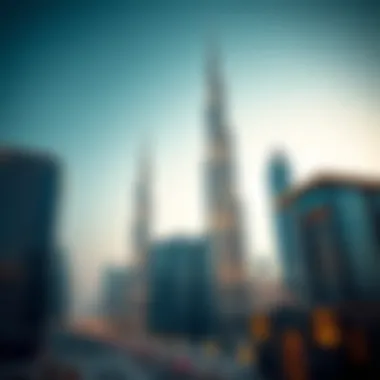
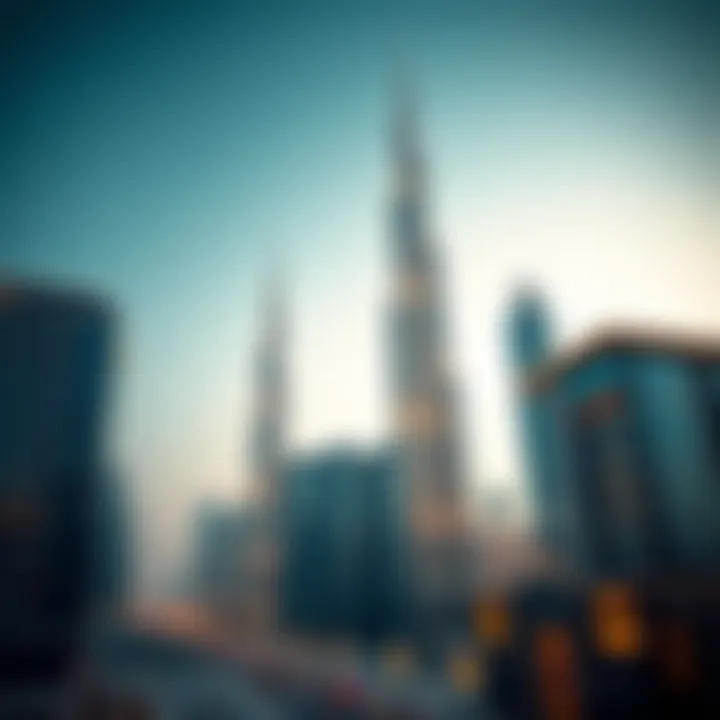
Standing at a staggering 414 meters, The Princess Tower takes its place as one of the tallest residential buildings in the world. Completed in 2012, this tower reflects a unique design that combines both luxury and functionality. With over 400 apartments, it offers a variety of layouts, appealing to a diverse array of residents.
The architecture showcases a blend of modern aesthetics with traditional elements, incorporating elegant curves and redefined geometric shapes. Its facade is clad in glass and concrete, which not only enhances its visual appeal but also reflects Dubai’s sparkling skyline. The building's height is complemented by amenities like swimming pools, gyms, and a rooftop observation deck, ensuring a lifestyle synonymous with opulence.
Moreover, the location in Dubai Marina provides residents with stunning views of the waterfront and easy access to vibrant entertainment districts, which adds to the overall living experience.
Marina 101: Engineering Feats
Marina 101, reaching 425 meters, is not just a testament to height; it illustrates cutting-edge engineering techniques prevalent in Dubai’s construction endeavors. Inaugurated in 2017, this tower is primarily a hotel and residence, housing both luxury accommodations and upscale living spaces. Its innovative design prioritizes efficient use of space while ensuring structural integrity.
This skyscraper employs a concrete core with a steel frame, making it one of the sturdiest structures around. The design angles of the building enhance wind resistance while providing an aesthetic flow to its exterior. Floors are meticulously crafted to allow for panoramic views of the surroundings, maximizing natural light and comfort.
Marina 101 stands not only as a place for living but as an engineering marvel that attracts attention from architects and engineers around the world, ensuring a strong interest in real estate as part of the waterfront lifestyle.
Jumeirah Emirates Towers: A Blend of Work and Leisure
The Jumeirah Emirates Towers encompass two skyscrapers that stand prominently at 355 meters each. These towers represent a curious mix of office space and hotel luxury, symbolizing Dubai's dual nature as a business hub and a tourist destination. They were completed in 2000 and have since become a landmark in their own right, showcasing Dubai’s ambition to merge commercial and hospitality aspects.
The design philosophy behind Jumeirah Emirates Towers focuses on creating synergy between work and leisure. The offices occupy one tower while the hotel takes the other, forming a bustling center where professionals and tourists intersect. With ample amenities like meeting rooms, restaurants, and fitness facilities, these towers provide a holistic environment for both local businesses and visitors.
Visually, the sleek glass and steel facade reflects the sun, adding to the dynamic character of the Dubai skyline. This blend of functionality and luxury makes these towers an attractive prospect for investors looking for commercial real estate with substantial potential for return on investment.
Economic Influence of Tall Buildings
The skyscrapers of Dubai are more than just striking visuals against the azure sky; they embody a vital component of the city’s economic framework. Their towering presence is a beacon for investment, tourism, and the lifestyle aspirations of residents. The ensuing sections will unpack the multifaceted economic implications of Dubai's tall buildings, revealing their roles as catalysts for growth and focal points for real estate development.
Real Estate Development Trends
In recent decades, the real estate market in Dubai has been a whirlwind of luxury developments, thanks in no small part to the tall buildings that define its skyline. The Princess Tower, for instance, encapsulates not just a height record but also the evolving tastes of investors and buyers alike. Skyscrapers often incorporate residential, commercial, and retail spaces within their structure, effectively contributing to mixed-use developments that enhance urban density and efficiency.
- Shifting Demographics: The arrival of expatriates drives demand for high-end housing, pushing developers to optimize vertical space.
- Luxury on Offer: A high-rise residential apartment in Dubai Marina isn’t just about living; it’s about a lifestyle choice paired with upscale amenities and breathtaking views.
As developers respond to market dynamics, they’re increasingly adopting innovative technologies that facilitate sustainable construction. The completion of projects like Marina 101 reflects a trend where luxury isn’t just the aim but a necessary expectation from buyers.
Investment Opportunities in High-Rise Properties
Investing in tall buildings in Dubai offers lucrative prospects that many investors find hard to resist. While historical patterns show real estate investment often following cyclical trends, the tall buildings have provided a backbone of stability amid fluctuations. Properties such as the Burj Khalifa continue to attract high net-worth individuals.
- Rental Yields: High-rise properties in strategic locations often yield higher rental returns due to their desirability.
- Capital Appreciation: As Dubai continues to grow, the value of prime real estate, particularly in the central business district, isn’t just an assumption; it’s a reality reflected in property prices ascending more steadily than local inflation.
Investors are also keen on potential developments near areas like Downtown Dubai and Business Bay, where high-rise projects are anticipated to reignite interest and foster competition.
Impact on Local Business Ecosystem
The presence of towering structures like the Jumeirah Emirates Towers doesn’t merely alter the skyline; it transforms the local business environment as well. These buildings often host multinational corporations, startups, and boutique firms, creating a vibrant ecosystem that can drive innovation and sustainability.
- Job Creation: With companies establishing their offices in high-rises, job opportunities surge, contributing positively to the employment rates in Dubai.
- Boosting Local Services: More businesses mean more demand for services, from restaurants and cafes to tech support and logistic services. This interconnectedness breathes life into neighborhoods and aids in creating a balanced economy.
It’s clear that tall buildings are not merely architectural feats but dynamic actors in the broader economic drama of Dubai. As they attract investments and foster local businesses, they pave the way for a future where both the skyline and the city’s economy can thrive together.
Sustainability Initiatives in Dubai's Tall Buildings
In an age where environmental considerations are paramount, the sustainability initiatives in Dubai’s towering skyline are not just fleeting trends but essential frameworks ensuring a greener future. Buildings like the Burj Khalifa demonstrate that sustainability can coexist with monumental design, showcasing how urban development can balance elegance with ecological responsibility. These initiatives are intricate, involving green building standards, pioneering energy efficiency innovations, and thoughtful integration of nature within the urban landscape. Together, they create a blueprint for a sustainable future in architecture that holds significance not just for Dubai but for global urban development at large.
Green Building Standards and Certifications
Adhering to stringent green building standards has become increasingly vital in Dubai. The Dubai Municipality has rolled out several certifications aimed at encouraging eco-friendly construction techniques. The Pearl Rating System is one such initiative, promoting sustainability in the UAE construction sector. It evaluates buildings on various criteria including energy usage, water management, and environmental impact.
- Benefits of these standards include:
- Reducing operational costs over time due to lower energy consumption.
- Enhancing building value as more buyers seek eco-friendly investments.
- Contributing to Dubai’s commitment of being a city that champions sustainable living.
This structured certification not only elevates the architectural quality but also pushes developers to create structures that align with the city’s environmental goals.
Energy Efficiency Innovations
Within the tall buildings of Dubai, innovations in energy efficiency are paving the way for a sustainable future. For instance, many buildings have switched to intelligent energy management systems that allow for real-time monitoring and control of energy usage. These systems utilize advanced data analytics to optimize heating, cooling, and lighting, thereby cutting down on waste and reducing the overall carbon footprint.
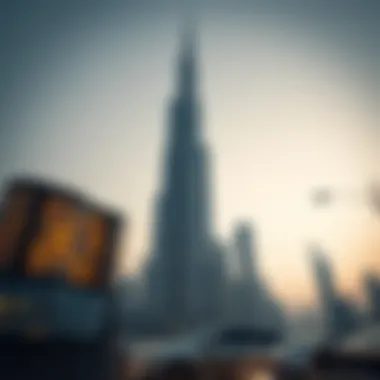

Some notable advancements include:
- Solar panels integrated into facades of buildings to harness renewable energy directly.
- High-efficiency HVAC systems that adapt to the building’s occupancy in real-time.
- Double-glazed windows that enhance insulation and reduce the reliance on artificial cooling.
Such innovative approaches not only meet regulatory standards but often exceed them, embedding a culture of sustainability within Dubai’s architectural ethos.
Integrating Nature with Urban Architecture
The vision of integrating nature within urban spaces is becoming a hallmark of Dubai’s skylines. Developers are increasingly realizing the benefits of creating green spaces within high-rise buildings. Incorporating elements like vertical gardens, green roofs, and communal parks not only enhances the aesthetic appeal but also fosters biodiversity.
- Importance of this integration includes:
- Providing residents with access to nature, improving their well-being and reducing stress.
- Creating habitats for local wildlife, promoting biodiversity in urban settings.
- Helping to lower urban temperatures and improve air quality.
By weaving nature into the very fabric of skyscrapers, Dubai is setting a precedence for cities around the world, proving that urbanization and greenery can thrive hand in hand.
“Incorporating green elements in high-rise buildings is not merely a trend; it is a necessity for a sustainable urban ecosystem.”
Through these initiatives, Dubai is not only enhancing its architectural landscape but also forging a sustainable identity that other metropolises might aspire to emulate.
Future Prospects: Towers on the Horizon
In the ever-evolving landscape of Dubai, the future holds immense promise for its skyline as new towers are set to redefine both its architecture and urban living. Understanding the future prospects of these projects, which include state-of-the-art skyscrapers, can shed light on how they will impact not just the skyline, but also the economic and social dynamics of this vibrant city. Engaging with this topic reveals the significant advancements in technology, sustainable practices, and innovative architectural designs that are anticipated. As investors, homebuyers, and property managers look toward the horizon, it's crucial to grasp these upcoming developments and their implications for both the market and the community.
Proposed Skyscrapers and Their Expected Features
The horizon of Dubai's architectural scene is peppered with ambitious projects that promise to be nothing short of spectacular. Notably, the Dubai Creek Tower is in the spotlight, poised to challenge the Burj Khalifa’s title of the tallest building in the world. Expected to rise over 1,000 meters, this tower aims to mimic the petals of a lily, incorporating organic shapes into its design.
Further, the Dubai One Tower aims to encapsulate luxury living and commercial spaces, utilizing advanced materials and smart building technologies that not only enhance aesthetics but also improve functionality.
Moreover, the W Dubai - Mina Seyahi is another remarkable proposal that blends the elements of sea and skyline, featuring an array of residential units designed for an upscale lifestyle. As these towers emerge, they will bring about refined amenities and services that meet the demands of modern life.
Urban Development Plans in Dubai
To accommodate the rapid pace of growth, Dubai’s urban planners have begun outlining extensive development plans that encompass not only the vertical expansions but horizontal growth as well. These plans prioritize mixed-use developments, which bring together residential, commercial, and recreational spaces, facilitating a live-work-play environment.
Such strategies include designating newer districts like
- Dubai South, which is conceived as a sustainable urban zone.
- Deira Islands, which aims to revitalize waterfront areas.
These developments are underpinned by meticulous transport infrastructure enhancement, ensuring seamless connectivity throughout. As a result, residents can enjoy proximity to amenities while contributing to an active economic landscape.
Architectural Visions for Sustainability
Sustainable architecture is taking center stage in the forthcoming towers of Dubai. Developers are increasingly recognizing their responsibilities towards the environment, hence integrated green practices are gaining traction.
Expected features include:
- Energy-efficient systems that harness solar power and minimize energy consumption.
- Rainwater harvesting solutions to promote responsible water usage and reduce reliance on municipal supply.
Adding to this, many upcoming towers are designed with an emphasis on green spaces, such as rooftop gardens that allow urban dwellers to connect with nature, enhancing their quality of life. The intent is to foster environments that support both physical wellbeing and community engagement.
"Sustainability isn’t just a trend; it's becoming the expectation in modern architecture, aiming for harmony between growth and environmental preservation."
The aspirations for these towers peak with a vision that seeks to balance luxury and environmental consciousness, shaping Dubai's identity for generations to come.
Integration of Technology in Tower Construction
The integration of technology in tower construction is an essential thread in the fabric of modern architecture in Dubai. These towering structures are not only feats of engineering but also exemplify how technology can streamline construction processes, enhance safety, and improve the overall functionality of buildings. With the construction of high-rises, precision and efficiency are paramount. Thus, the incorporation of advanced technologies is critical, influencing everything from foundational design to daily management.
Use of Smart Technology in High-Rises
Smart technology serves as the backbone of modern skyscrapers, facilitating seamless interactions between residents and the building itself. These technologies range from integrated systems that control lighting and climate to security features that ensure residents' safety.
- Building Management Systems (BMS): Basic operations like heating, ventilation, and air conditioning can be automated, optimizing energy use considerably. This not just cuts costs but lowers environmental impact.
- Smart Sensors: Sensors can monitor everything from occupancy levels to air quality, allowing for real-time adjustments. For instance, in buildings like the Burj Khalifa, sensors adjust lighting based on the time of day, ensuring that energy is not wasted.
By employing an array of smart technologies, developers are not simply building living spaces; they are creating environments that cater to the evolving demands of urban life.
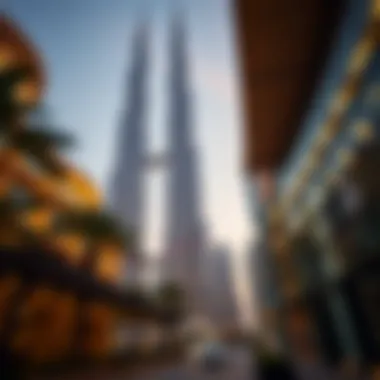
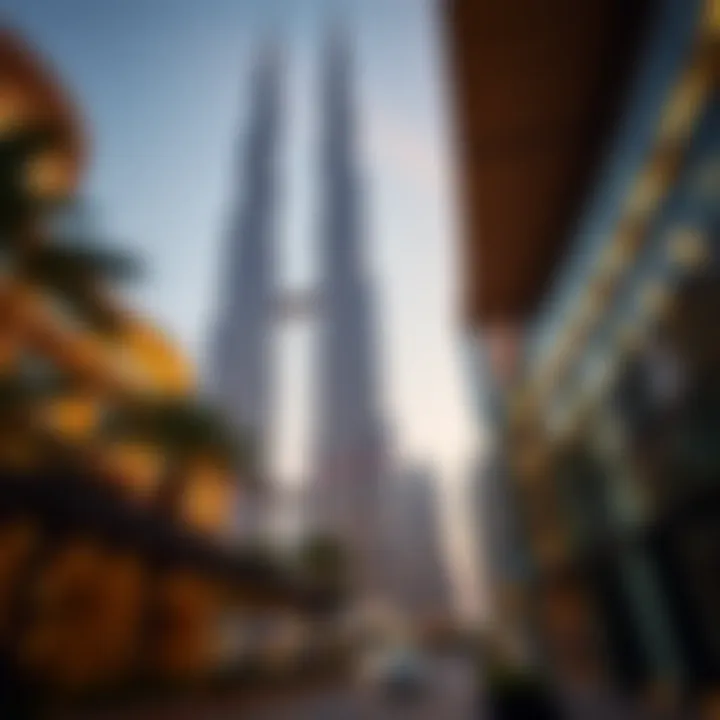
Automation in Building Management
Automation in building management is revolutionizing how skyscrapers operate. In a city like Dubai, where the pace of life runs fast, these automated features ensure continuity and harmony in daily activities within high-rises.
- Centralized Control: An advanced control system allows property managers to oversee multiple facets of the building from one location. These systems make it possible to streamline maintenance schedules and enhance overall efficiency.
- Predictive Maintenance: With automation, buildings can alert management about required maintenance before it becomes a problem. This predictive approach ensures that systems are serviced at the right moment, avoiding costly repairs or unsafe conditions.
The seamlessness of automation means that residents can focus on their lives rather than the minutiae of building management.
Data Analysis for Structural Safety
In a city characterized by its towering structures, ensuring structural safety is non-negotiable. Data analysis plays a pivotal role in maintaining the integrity and safety of skyscrapers.
- Real-Time Monitoring: Through the use of advanced sensors and data analytics tools, skyscrapers can monitor structural integrity continuously. Measurements like stress, strain, and temperature are recorded, allowing for immediate responses to any detected anomalies.
- Historical Data Utilization: By analyzing trends over time, construction teams can understand how structures perform under various conditions. This capability enables engineers to anticipate potential weaknesses and reinforce them proactively.
"Data isn't just numbers; it’s the backbone of safety in skyscrapers, especially where wind and weather can challenge the integrity of these colossal structures."
Social Aspects of Tower Living
The concept of tower living encompasses much more than just the physical space that inhabitants occupy. In a city as bustling as Dubai, where skyscrapers dominate the skyline, the social dynamics within these monumental structures play a crucial role in the experience of their residents. As urban populations grow and lifestyles evolve, understanding these social aspects becomes essential—not only for potential residents but also for investors and property managers aiming to enhance the living experience within these towers.
Community Dynamics within Skyscrapers
Living in a high-rise creates a unique sense of community, albeit one that differs from traditional neighborhood settings. Residents of towers often come from diverse backgrounds, fostering a multicultural environment where various languages and customs intertwine. This mixture can lead to blossoming friendships and support systems, as shared spaces like gyms, lounges, and pools bring people together.
Furthermore, the architecture of these buildings often encourages interaction. For instance, open-air terraces or communal gardens become melting pots for residents. Tower dwellers might find common ground while enjoying breathtaking views or sipping coffee under the Dubai sun. Therefore, community dynamics within these skyscrapers can greatly enhance the quality of life, fostering a sense of belonging amidst a sprawling city.
Lifestyle Considerations for Residents
When it comes to lifestyle in tower living, convenience is the name of the game. High-rise buildings frequently come equipped with modern amenities that cater to the fast-paced lives of their residents. From fitness centers to rooftop lounges, these features support a lifestyle that prioritizes both comfort and health. Access to on-site services such as grocery stores, cafes, and even childcare facilities saves time, a commodity highly valued in today’s world.
However, lifestyle in these towers is not without its challenges. Some residents may feel distanced from their neighbors due to the sheer size of the building or the fast-paced nature of city life. Privacy can sometimes feel like a luxury. Therefore, it is crucial for property managers to create programs that foster engagement among residents, such as social clubs or community events, to counter this isolation.
Cultural Interactions in High-Rise Environments
Skyscrapers are not just homes; they’re cultural hubs that represent the convergence of global influences. In Dubai, especially, towers often host residents from across the globe, creating incredible opportunities for cross-cultural interactions. With people sharing an elevator, attending the same social events, or simply enjoying the facilities together, residents can gain insights into each other’s customs, cuisines, and lifestyles.
This cultural richness can greatly enhance the living experience, as residents often find themselves celebrating different festivals or participating in communal activities that highlight various traditions. However, achieving this cultural synergy requires careful planning and consideration from developers to ensure that spaces within the building are conducive to such interactions.
In skyscraper societies, every floor tells a story, each apartment a different culture; understanding how these narratives intertwine is key to appreciating tower living.
In summary, the social aspects of tower living in Dubai come with both great benefits and challenges. Understanding community dynamics, lifestyle considerations, and cultural interactions is crucial for anyone interested in these architectural marvels. With thoughtful engagement and an inclusive approach, the skyscrapers of Dubai can become more than just residences; they can foster vibrant, interconnected communities.
Finale: The Legacy of Dubai's Towers
As we reach the final stretch of our exploration into Dubai's impressive skyline, it's clear that the tallest towers in the city are not just architectural feats but also symbols of ambition, innovation, and cultural interplay. These towering giants have reshaped the identity of Dubai, standing tall against the backdrop of a rapidly evolving global city.
The legacy of these structures is multifaceted. Firstly, the contribution to the cityscape is nothing short of transformative. Buildings like the Burj Khalifa and the Princess Tower have become reference points, making their mark on both the visual horizon and the tourism landscape. Their distinct designs invite admiration from every corner, pushing the envelope in what can be achieved in tall building engineering.
Moreover, these skyscrapers serve as a beacon of economic stimulation. From creating thousands of jobs during their construction phase to acting as hubs of commerce and residence, tall towers have significantly bolstered Dubai’s economy. They attract investors and visitors alike, bringing in a flow of income that is crucial for the region's continued development.
Also, we can’t ignore the cultural implications that arise from living and working in such vertical spaces. The social architecture formed within these towers encourages a unique community interaction that traditional urban models may not facilitate. Residents and businesses share not just space but experiences, forming networks that reflect the cosmopolitan nature of this flourishing city.
In essence, the legacy of Dubai's towers is a tapestry woven from threads of art, engineering, and pragmatism. As the skyline evolves, these buildings remind us of what has been accomplished and hint at what is still possible in the realm of sustainable and forward-thinking design.
Summarizing the Impact on the Cityscape
The impact of Dubai's skyscrapers goes beyond mere aesthetics. Each tall structure contributes to the personality of the city, shaping its image regionally and globally. For instance, the Burj Khalifa, the tallest building in the world, stands as a testament to human ingenuity and determination. It represents a fusion of modernism with rich Arabian heritage.
Key impacts include:
- Iconic Status: Landmarks like the Burj Khalifa and Marina 101 are etched in the minds of world travelers, placing Dubai prominently on the global map.
- Tourism Boost: The architectural wonders attract millions of tourists, contributing considerably to local businesses and the economy.
- Real Estate Catalysts: High-rise living options have diversified the real estate market, providing exclusive living spaces that cater to various demographics.
What’s more, these skyscrapers act as hubs of forward-thinking urban planning, encouraging vertical growth over horizontal sprawl. As urban areas face challenges regarding space efficiency and sustainability, it's undeniable that these towering edifices play a crucial role in mitigating those challenges.
Future of Architectural Development in Dubai
As we look ahead, one cannot help but wonder what the future holds for architectural development in Dubai. With an unwavering vision for innovation and sustainability, the city seems poised to continue its ascent into the skies.
Several trends paint a picture of what’s to come:
- Sustainable Designs: Future towers are set to amplify sustainability, aiming for energy efficiency and minimal environmental impact. The focus on technologies such as solar panels and sustainable materials is anticipated to grow.
- Smart Buildings: The integration of smart technology will enhance building functionality, from security to energy management, promoting a seamless living or working environment.
- Community-Centric Spaces: There's an increasing emphasis on fostering community interaction within these vertical neighborhoods. Developers are exploring more mixed-use designs that blend residential, commercial, and recreational spaces.
Ultimately, the future of architectural development in Dubai is not just about reaching new heights; it’s about creating spaces that cater to human experiences and needs while laying the groundwork for a sustainable future. As architects and engineers continue to push the boundaries, we can expect Dubai’s skyline to evolve even further, solidifying its status as one of the leading destinations for modern architectural excellence.













